Design and Fabrication of a Triple-Band Terahertz Metamaterial Absorber
Abstract
1. Introduction
2. Structure and Design
3. Simulation Results and Discussion
| Ref. | Structure | Unit Size (μm) | Waveband (THz) | Peak Numbers | The First Peak Absorption | The Second Peak Absorption | The Third Peak Absorption | Polarization | Experiment |
|---|---|---|---|---|---|---|---|---|---|
| [31] | Au resonators-SiO2-Au | 0.6 | 100–300 | 3 | 96.8% | 99.6% | 99.2% | insensitive | No |
| [35] | Au resonators-Si-Au | 200 | 0.1–1 | 3 | 97.6% | 96.5% | 84.1% | insensitive | No |
| [36] | Al resonators- polyimide -Al | 300 | 0.15–0.85 | 3 | 80% | 81% | 79% | sensitive | Yes |
| [37] | Au resonators-GaAs-Au | 30 | 1–6 | 3 | 99.4% | 99.6% | 98.2% | insensitive | No |
| [38] | Au resonators- dielectric- Au resonators- dielectric- Au resonators- dielectric-Au | 60 | 0.8–3.7 | 3 | Nearly 100% | Nearly 100% | Nearly 100% | sensitive | No |
| This work | Al resonators -PET-Al | 150 | 0.1–1 | 3 | 99.5%, | 86.4% | 98.4% | insensitive | Yes |
| Ref. | Waveband (THz) | S(GHz/RIU)/Peak 1 | S(GHz/RIU)/Peak 2 | S(GHz/RIU)/Peak 3 |
|---|---|---|---|---|
| [12] | 0.5–3 | 1150 | 3050 | - |
| [36] | 0.15–0.85 | 54.18 | 119.2 | 139.2 |
| [41] | 0.5–4.5 | 83 | 100 | 125 |
| This work | 0.1–1 | 72 | 103.5 | 139.5 |
4. Experiment and Results
5. Conclusions
Author Contributions
Funding
Data Availability Statement
Conflicts of Interest
References
- Wang, T.; Shen, S.; Liu, J.-J.; Zhang, Y.-S.; Han, Z.-H. Experimental realization of perfect terahertz plasmonic absorbers using highly doped silicon substrate and COMS-compatible techniques. Opt. Mater. Express 2016, 6, 523–530. [Google Scholar] [CrossRef]
- Oraizi, H.; Abdolali, A.; Vaseghi, N. Application of Double Zero Metamaterials as Radar Absorbing Materials for the Reduction of Radar Cross Section. Prog. Electromagn. Res. 2010, 101, 323–337. [Google Scholar] [CrossRef]
- Federici, J.F.; Moeller, L. Review of terahertz and subterahertz wireless communications. J. Appl. Phys. 2010, 107, 111101. [Google Scholar] [CrossRef]
- Diem, M.; Koschny, T.; Soukoulis, C.M. Wide-angle perfect absorber/thermal emitter in the terahertz regime. Phys. Rev. B 2009, 79, 033101. [Google Scholar] [CrossRef]
- Jepsen, P.U.; Cooke, D.G.; Koch, M. Terahertz spectroscopy and imaging—Modern techniques and applications. Laser Photonics Rev. 2010, 5, 124–166. [Google Scholar] [CrossRef]
- Shalaev, V.M. Optical negative-index metamaterials. Nat. Photonics 2007, 1, 41–48. [Google Scholar] [CrossRef]
- Zheludev, N.I.; Kivshar, Y.S. From metamaterials to metadevices. Nat. Photonics 2012, 11, 917–924. [Google Scholar] [CrossRef]
- Zhou, H.; Pei, Z.; Qu, S.; Zhang, S.; Wang, J.; Li, Q.; Xu, Z. A planar zero-index metamaterial for directive emission. J. Electromagn. Waves Appl. 2009, 23, 953–962. [Google Scholar] [CrossRef]
- Schurig, D.; Mock, J.J.; Justice, B.J.; Cummer, S.A.; Pendry, J.B.; Starr, A.F.; Smith, D.R. Metamaterial Electromagnetic Cloak at Microwave Frequencies. Science 2006, 314, 977–980. [Google Scholar] [CrossRef]
- Tang, J.; Xiao, Z.; Xu, K.; Ma, X.; Liu, D.; Wang, Z. Cross polarization conversion based on a new chiral spiral slot structure in THz region. Opt. Quantum Electron. 2016, 48, 1–11. [Google Scholar] [CrossRef]
- Iwaszczuk, K.; Strikwerda, A.C.; Fan, K.; Zhang, X.; Averitt, R.D.; Jepsen, P.U. Flexible metamaterial absorbers for stealth applica-tions at terahertz frequencies. Opt. Express 2012, 20, 635–643. [Google Scholar] [CrossRef]
- Xie, Q.; Dong, G.; Wang, B.-X.; Huang, W.-Q. Design of Quad-Band Terahertz Metamaterial Absorber Using a Perforated Rectangular Resonator for Sensing Applications. Nanoscale Res. Lett. 2018, 13, 137. [Google Scholar] [CrossRef]
- Hao, J.; Wang, J.; Liu, X.-L.; Willie, J.P.; Zhou, L.; Qiu, M. High performance optical absorber based on a plasmonic metamate-rial. Appl. Phys. Lett. 2010, 96, 251104. [Google Scholar] [CrossRef]
- Wang, B. Quad-band terahertz metamaterial absorber based on the combing of the dipole and quadrupole resonances of two SRRs. IEEE J. Select Top. Quantum Electron. 2017, 23, 4700107. [Google Scholar] [CrossRef]
- Savo, S.; Shrekenhamer, D.; Padilla, W.J. Liquid Crystal Metamaterial Absorber Spatial Light Modulator for THz Applications. Adv. Opt. Mater. 2014, 2, 275–279. [Google Scholar] [CrossRef]
- Wang, H.; Chang, J.; Yang, Y.; Wang, L.-P. Performance analysis of solar thermophotovoltaic conversion enhanced by selec-tive metamaterial absorbers and emitters. Int. J. Heat Mass. Transf. 2016, 98, 788–798. [Google Scholar] [CrossRef]
- Zhang, B.; Hendrickson, J.; Guo, J. Multispectral near-perfect metamaterial absorbers using spatially multiplexed plasmon resonance metal square structures. J. Opt. Soc. Am. B 2013, 30, 656–662. [Google Scholar] [CrossRef]
- Hu, X.; Xu, G.; Wen, L.; Wang, H.; Zhao, Y.; Zhang, Y.; Cumming, D.R.S.; Chen, Q. Metamaterial absorber integrated microfluidic terahertz sensors. Laser Photonics Rev. 2016, 10, 962–969. [Google Scholar] [CrossRef]
- Zou, H.; Cheng, Y. Design of a six-band terahertz metamaterial absorber for temperature sensing application. Opt. Mater. 2019, 88, 674–679. [Google Scholar] [CrossRef]
- Landy, N.I.; Sajuyigbe, S.; Mock, J.J.; Smith, D.R.; Padilla, W.J. Perfect Metamaterial Absorber. Phys. Rev. Lett. 2008, 100, 207402. [Google Scholar] [CrossRef]
- Kim, S.L.K. Optical absorption characteristic in thin a-Si film embedded between an ultrathin metal grating and a metal re-flector. IEEE Photonics J. 2013, 5, 00610. [Google Scholar]
- Care, V.A.; Mirotznik, M.S. Multiband absorbers for the long-wave infrared regime. Appl. Opt. 2017, 56, 8403–8413. [Google Scholar] [CrossRef] [PubMed]
- Wang, J.; Lang, T.; Hong, Z.; Shen, T.; Wang, G. Tunable terahertz metamaterial absorber based on electricity and light modulation modes. Opt. Mater. Express 2020, 10, 2262–2273. [Google Scholar] [CrossRef]
- Cheng, Y.; Zou, Y.; Luo, H.; Chen, F.; Mao, X. Compact Ultra-Thin Seven-Band Microwave Metamaterial Absorber Based on a Single Resonator Structure. J. Electron. Mater. 2019, 48, 3939–3946. [Google Scholar] [CrossRef]
- Jia, W.; Bai, J.; Roberts, K.; Le, K.Q.; Zhou, D. Design and simulation of a polarization-insensitive metamaterial terahertz absorber with five bands. Microw. Opt. Technol. Lett. 2020, 62, 2649–2655. [Google Scholar] [CrossRef]
- Wang, B.-X.; Wang, G.-Z.; Sang, T. Simple design of novel triple-band terahertz metamaterial absorber for sensing application. J. Phys. D Appl. Phys. 2016, 49, 165307. [Google Scholar] [CrossRef]
- Bakshi, S.C.; Mitra, D.; Minz, L. A compact design of multiband terahertz metamaterial absorber with frequency and polari-zation tunability. Plasmonics 2018, 13, 1843–1852. [Google Scholar] [CrossRef]
- Park, J.W.; Tuong, P.V.; Rhee, Y.J.; Kim, K.W.; Jang, W.H.; Choi, E.H.; Chen, L.-Y.; Lee, Y.P. Multi-band metamaterial ab-sorber based on the arrangement of donut-type resonators. Opt. Express 2013, 21, 9691–9702. [Google Scholar] [CrossRef] [PubMed]
- Wang, B.X.; Zhai, X.; Wang, G.Z.; Huang, W.-Q.; Wang, L.L. Design of a Four-Band and Polarization-Insensitive Terahertz Metamaterial Absorber. IEEE Photonics J. 2014, 7, 1–8. [Google Scholar] [CrossRef]
- Zheng, D.; Cheng, Y.; Cheng, D.; Nie, Y.; Gong, R.Z. Four-Band Polarization-Insensitive Metamaterial Absorber Based on Flower-Shaped Structures. Prog. Electromagn. Res. 2013, 142, 221–229. [Google Scholar] [CrossRef]
- Qin, F.; Chen, Z.; Chen, X.; Yi, Z.; Yao, W.; Duan, T.; Wu, P.; Yang, H.; Li, G.; Yi, Y. A Tunable Triple-Band Near-Infrared Metamaterial Absorber Based on Au Nano-Cuboids Array. Nanomaterials 2020, 10, 207. [Google Scholar] [CrossRef]
- Ahmadivand, A.; Sinha, R.; Karabiyik, M.; Vabbina, P.K.; Gerislioglu, B.; Kaya, S.; Pala, N. Tunable THz wave absorption by graphene-assisted plasmonic metasurfaces based on metallic split ring resonators. J. Nanoparticle Res. 2016, 19, 3. [Google Scholar] [CrossRef]
- Cole, M.A.; Powell, D.A.; Shadrivov, I.V. Strong terahertz absorption in all-dielectric Huygens’ metasurfaces. Nanotechnology 2016, 27, 424003. [Google Scholar] [CrossRef]
- Mayer, M.; Tebbe, M.; Kuttner, C.; Schnepf, M.J.; König, T.; Fery, A. Template-assisted colloidal self-assembly of macro-scopic magnetic metasurfaces. Faraday Discuss. 2016, 191, 159–176. [Google Scholar] [CrossRef] [PubMed]
- Arezoomand, A.S.; Zarrabi, B.F.; Heydari, S.; Gandjic, N.P. Independent polarization and multi-band THz absorber base on Jerusalem cross. Opt. Commun. 2015, 352, 121–126. [Google Scholar] [CrossRef]
- Yahiaoui, R.; Tan, S.; Cong, L.Q.; Singh, R.; Yan, F.-P.; Zhang, W.-L. Multispectral terahertz sensing with highly flexible ul-trathin metamaterial absorber. J. Appl. Phys. 2015, 118, 083103. [Google Scholar] [CrossRef]
- Huang, X.; Lu, C.; Rong, C.; Hu, Z.; Liu, M. Multiband Ultrathin Polarization-Insensitive Terahertz Perfect Absorbers with Complementary Metamaterial and Resonator Based on High-Order Electric and Magnetic Resonances. IEEE Photonics J. 2018, 10, 1–11. [Google Scholar] [CrossRef]
- Wang, B.-X.; Tang, C.; Niu, Q.; He, Y.; Chen, T. Design of Narrow Discrete Distances of Dual-/Triple-Band Terahertz Metamaterial Absorbers. Nanoscale Res. Lett. 2019, 14, 1–7. [Google Scholar] [CrossRef]
- Cheng, X.-M.; Huang, R.; Jimmy, X.; Xu, X.-D. Broadband terahertz near-perfect absorbers. ACS Appl. Mater. Interfaces 2020, 12, 33352–33360. [Google Scholar] [CrossRef]
- Xu, W.; Huang, Y.; Zhou, R.; Wang, Q.; Yin, J.; Kono, J.; Ping, J.; Xie, L.; Ying, Y. Metamaterial-Free Flexible Graphene-Enabled Terahertz Sensors for Pesticide Detection at Bio-Interface. ACS Appl. Mater. Interfaces 2020, 12, 44281–44287. [Google Scholar] [CrossRef]
- Lou, P.; He, Y.; Zhu, H.; Zhang, X.; Hu, L.; Wang, B.-X. Multiple-band terahertz perfect light absorbers enabled by using multiple metallic bars. Phys. Scr. 2021, 96, 055502. [Google Scholar] [CrossRef]
- Shen, X.; Yang, Y.; Zang, Y.; Gu, J.; Han, J.; Zhang, W.; Cui, T.J. Triple-band terahertz metamaterial absorber: Design, experiment, and physical interpretation. Appl. Phys. Lett. 2012, 101, 154102. [Google Scholar] [CrossRef]
- Wang, J.; Chen, Y.; Hao, J.; Yan, M.; Qiu, M. Shape-dependent absorption characteristics of three-layered metamaterial absorbers at near-infrared. J. Appl. Phys. 2011, 109, 074510. [Google Scholar] [CrossRef]
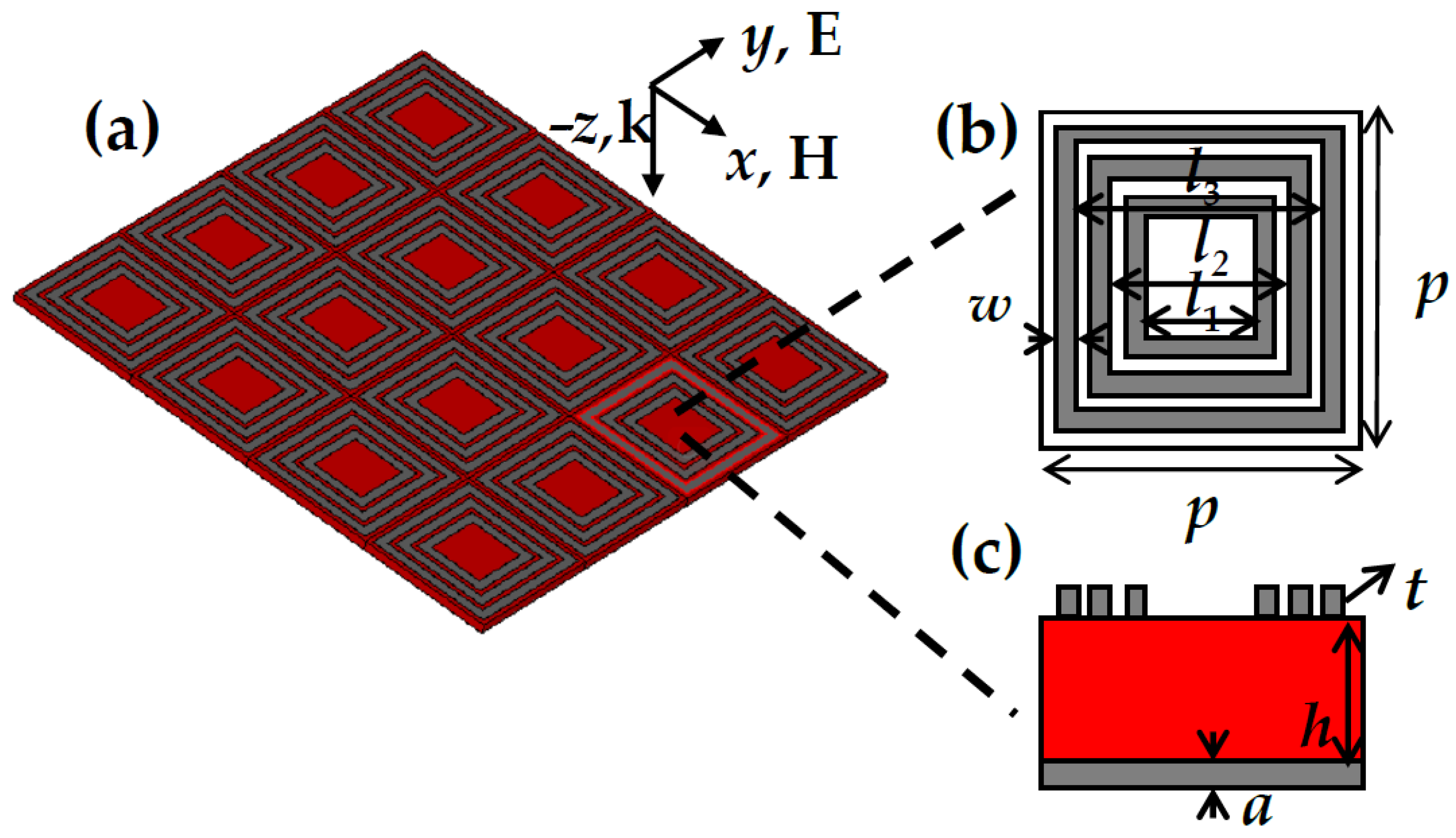
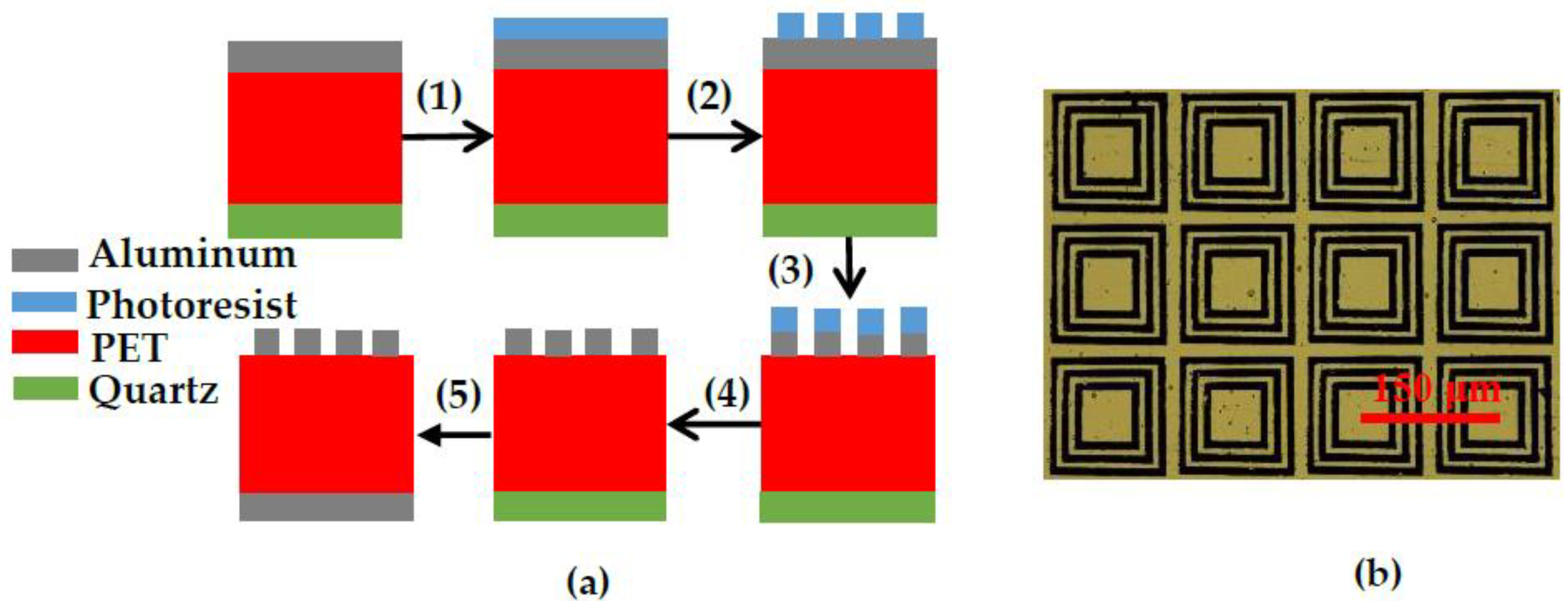
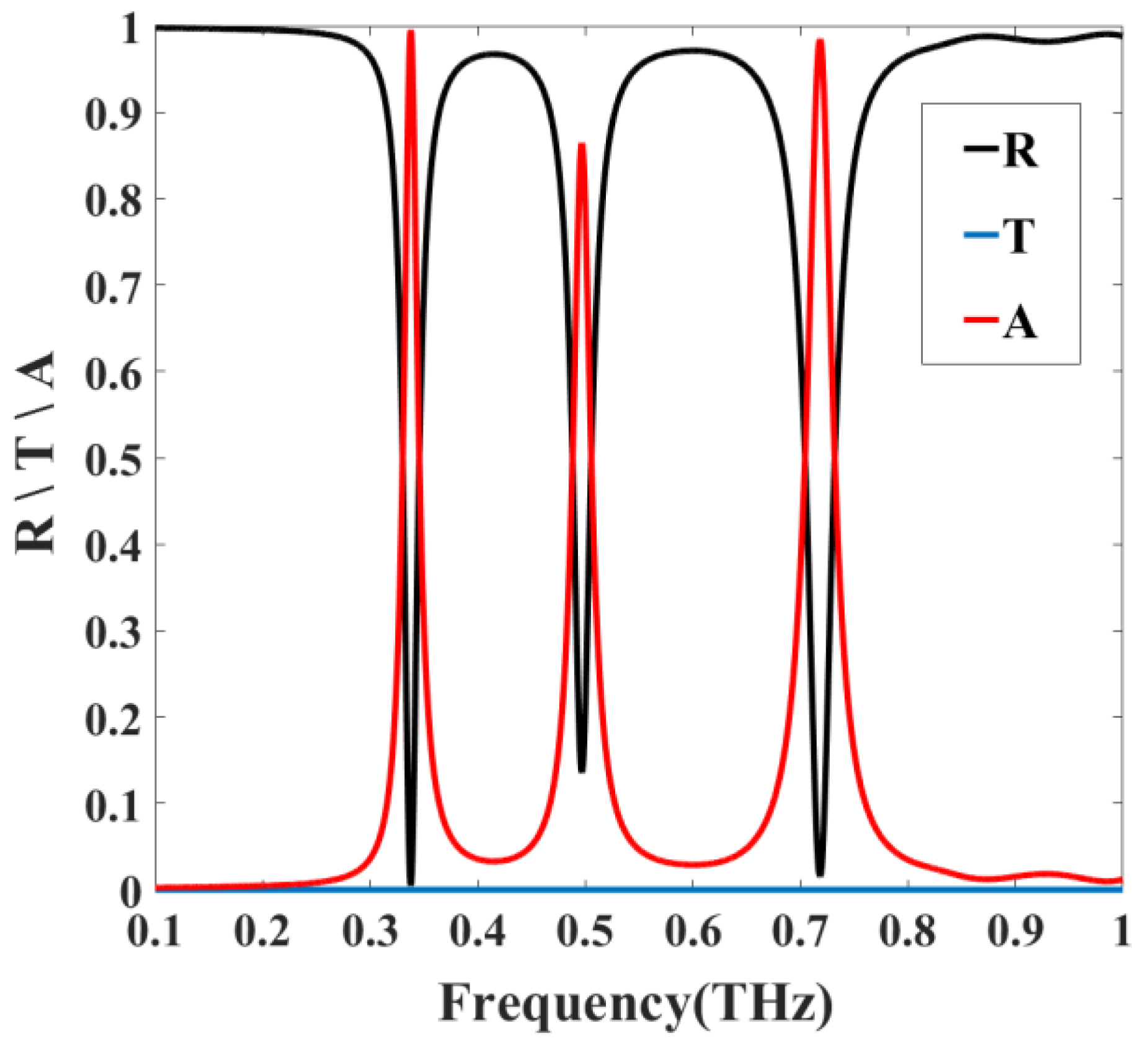
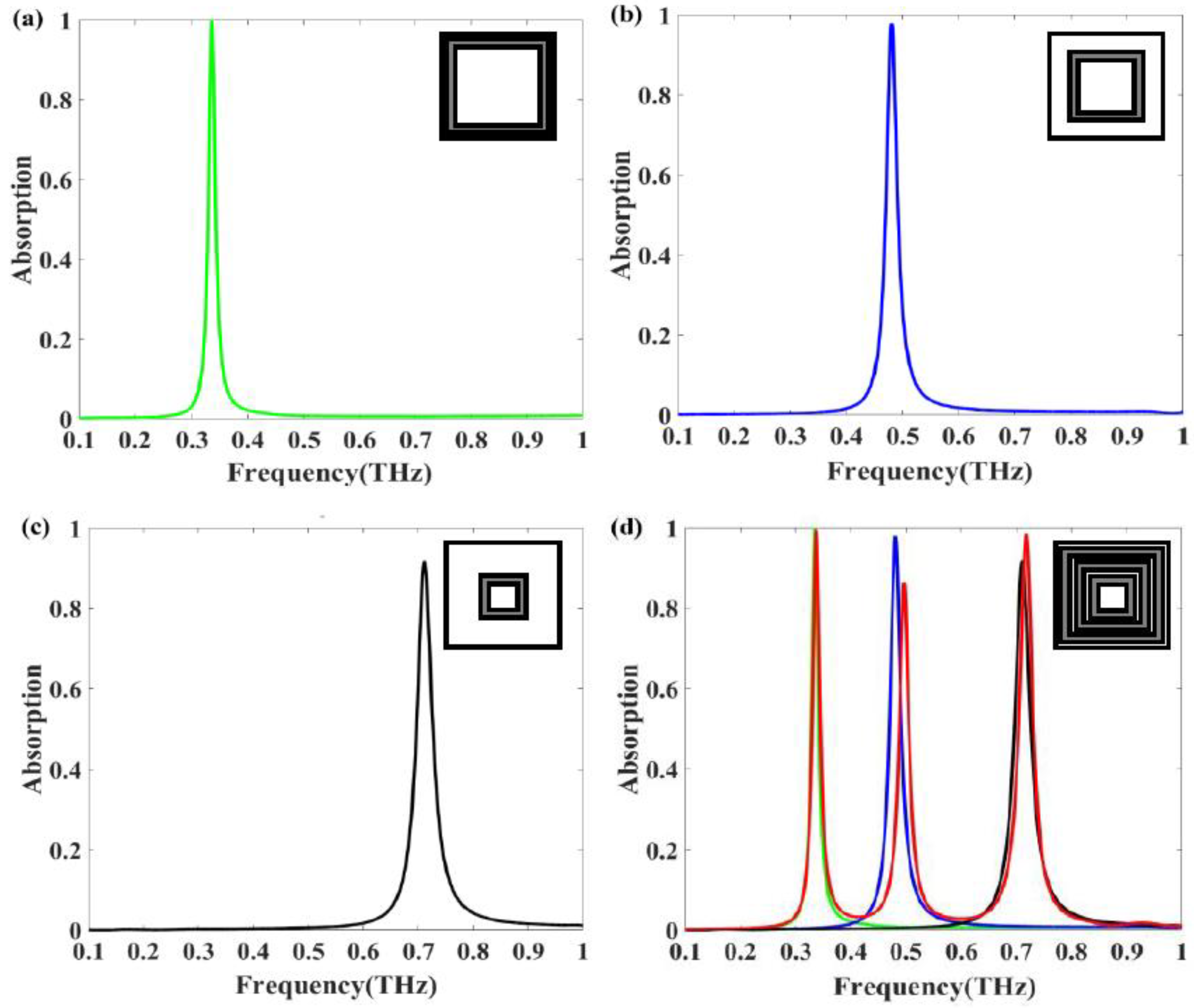

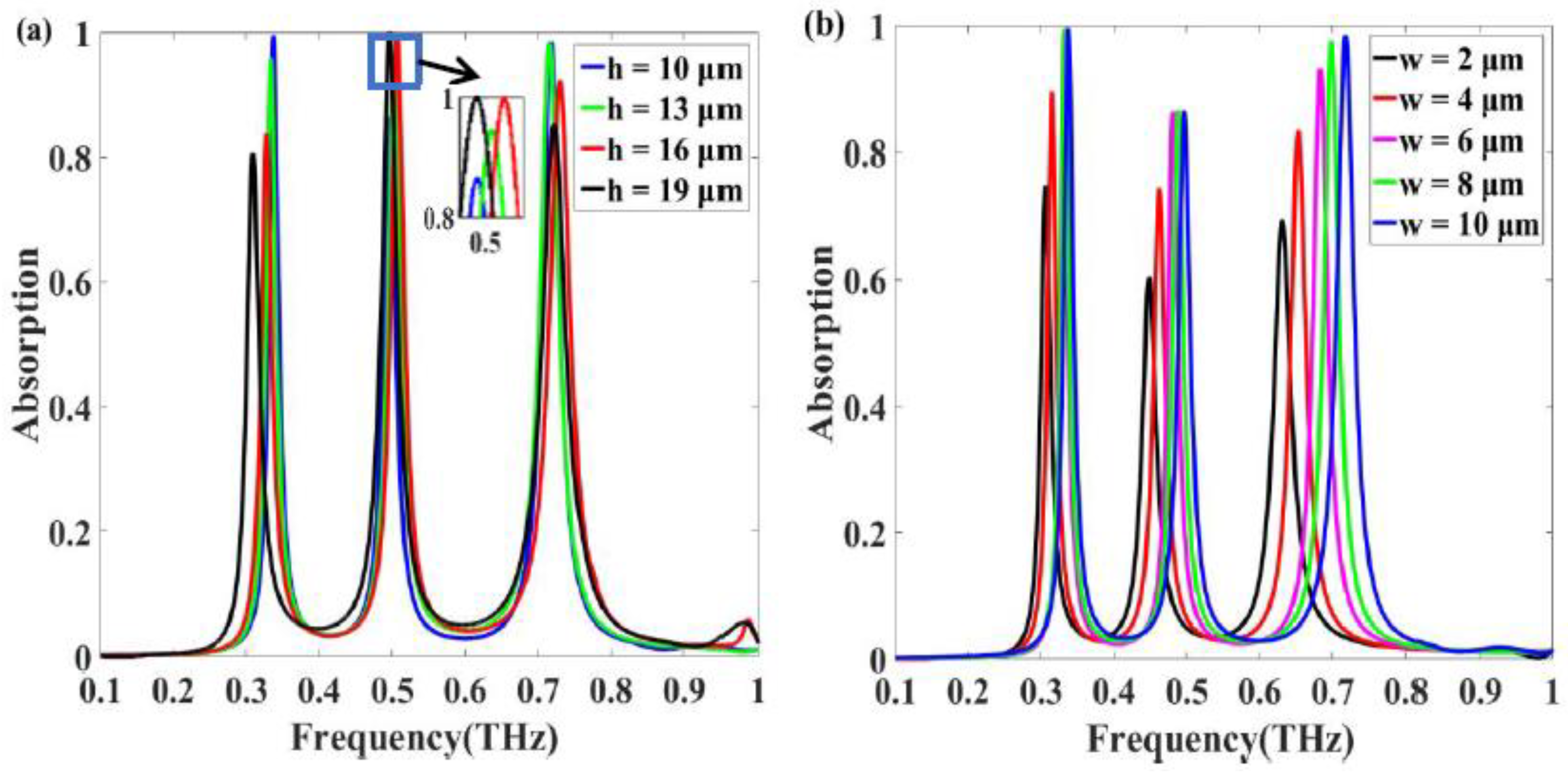

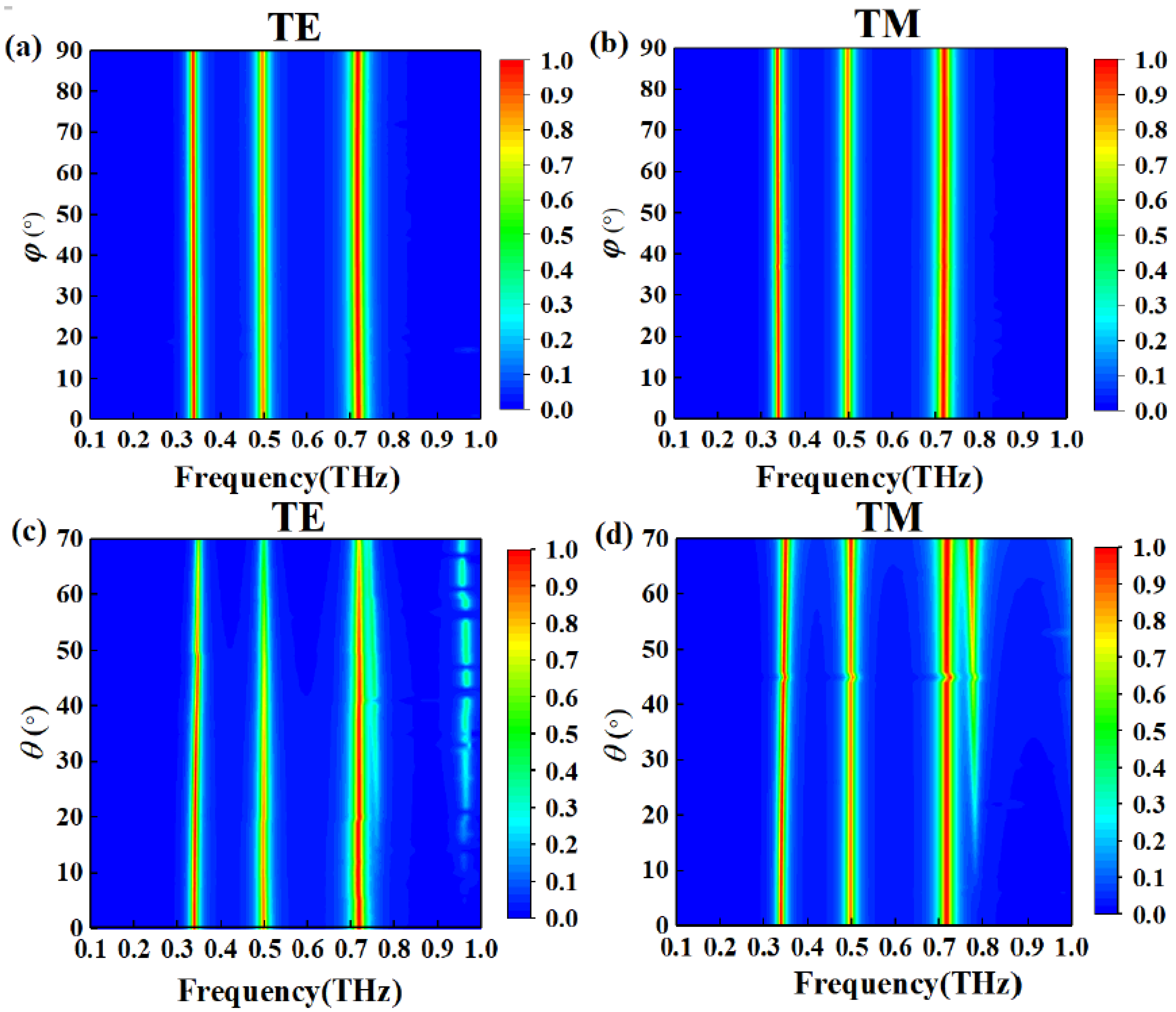

Publisher’s Note: MDPI stays neutral with regard to jurisdictional claims in published maps and institutional affiliations. |
© 2021 by the authors. Licensee MDPI, Basel, Switzerland. This article is an open access article distributed under the terms and conditions of the Creative Commons Attribution (CC BY) license (https://creativecommons.org/licenses/by/4.0/).
Share and Cite
Wang, J.; Lang, T.; Hong, Z.; Xiao, M.; Yu, J. Design and Fabrication of a Triple-Band Terahertz Metamaterial Absorber. Nanomaterials 2021, 11, 1110. https://doi.org/10.3390/nano11051110
Wang J, Lang T, Hong Z, Xiao M, Yu J. Design and Fabrication of a Triple-Band Terahertz Metamaterial Absorber. Nanomaterials. 2021; 11(5):1110. https://doi.org/10.3390/nano11051110
Chicago/Turabian StyleWang, Jinfeng, Tingting Lang, Zhi Hong, Meiyu Xiao, and Jing Yu. 2021. "Design and Fabrication of a Triple-Band Terahertz Metamaterial Absorber" Nanomaterials 11, no. 5: 1110. https://doi.org/10.3390/nano11051110
APA StyleWang, J., Lang, T., Hong, Z., Xiao, M., & Yu, J. (2021). Design and Fabrication of a Triple-Band Terahertz Metamaterial Absorber. Nanomaterials, 11(5), 1110. https://doi.org/10.3390/nano11051110






